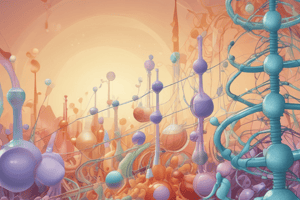Podcast
Questions and Answers
What type of bonds are involved in the quaternary structure of proteins?
What type of bonds are involved in the quaternary structure of proteins?
- Disulfide bonds
- Covalent bonds
- Peptide bonds
- Hydrogen bonds, hydrophobic interactions, and ionic bonds (correct)
What is the primary function of haemoglobin, an example of an oligomeric protein?
What is the primary function of haemoglobin, an example of an oligomeric protein?
- Transportation of oxygen (correct)
- Cellular signaling
- Storage of amino acids
- Regulation of metabolism
What is the classification of proteins based on their composition?
What is the classification of proteins based on their composition?
- Structural, enzymatic, and transport proteins
- Complete, incomplete, and conditional proteins
- Simple, conjugated, and derived proteins (correct)
- Primary, secondary, and tertiary proteins
Which of the following is an example of a conjugated protein?
Which of the following is an example of a conjugated protein?
What is the function of structural proteins?
What is the function of structural proteins?
Which of the following proteins is classified as a complete protein?
Which of the following proteins is classified as a complete protein?
What is the classification of proteins based on their function?
What is the classification of proteins based on their function?
What is the term for proteins that are obtained by degradation of simple or conjugated proteins?
What is the term for proteins that are obtained by degradation of simple or conjugated proteins?
What is the purpose of the Biuret reaction in biological solutions?
What is the purpose of the Biuret reaction in biological solutions?
What is the function of Glutathione in preventing oxidation of sulfhydryl groups?
What is the function of Glutathione in preventing oxidation of sulfhydryl groups?
What is the role of Glutathione in the transport of amino acids?
What is the role of Glutathione in the transport of amino acids?
What is the function of Tryotropin releasing hormone (TRH)?
What is the function of Tryotropin releasing hormone (TRH)?
What is the function of Angiotensin II?
What is the function of Angiotensin II?
What is the function of Glutathione peroxidase?
What is the function of Glutathione peroxidase?
What is the function of Enkephalins?
What is the function of Enkephalins?
What is the function of Vasopressin?
What is the function of Vasopressin?
What percentage of cellular dry weight do proteins make up?
What percentage of cellular dry weight do proteins make up?
What is the origin of the word 'protein'?
What is the origin of the word 'protein'?
What is the primary function of clotting factor proteins?
What is the primary function of clotting factor proteins?
What is the name of the Swedish chemist who suggested the name 'proteins'?
What is the name of the Swedish chemist who suggested the name 'proteins'?
What are the five major elements that make up proteins?
What are the five major elements that make up proteins?
What is the term for the classification of proteins based on their structures?
What is the term for the classification of proteins based on their structures?
What is the role of enzymes in the body?
What is the role of enzymes in the body?
What is the term for proteins that provide structural support and strength to cells?
What is the term for proteins that provide structural support and strength to cells?
Flashcards are hidden until you start studying
Study Notes
Colour Reactions of Proteins
- Biuret reaction is a common method to detect proteins in biological solutions, producing a purple colour when biuret is treated with dilute copper sulphate in an alkaline medium.
Biologically Important Peptides
- Glutathione is a coenzyme for certain enzymes, prevents oxidation of sulfhydryl groups of proteins, participates in the formation of correct disulfide bonds in proteins, and maintains RBC membrane structure and integrity.
- Glutathione also protects haemoglobin from oxidation, is involved in the transport of amino acids, and participates in detoxification processes.
- Other biologically important peptides include:
- Tryotropin releasing hormone (TRH), produced in the hypothalamus, stimulates the pituitary gland to release thyrotropic hormone.
- Oxytocin, secreted by the posterior pituitary gland, is involved in uterine contraction.
- Vasopressin, produced by the posterior pituitary gland, stimulates water retention by the kidneys.
- Enkephalins, also known as encephalins, inhibit the sense of pain in the brain.
- Angiotensins, Angiotensin II has hypertensive effects and stimulates the release of aldosterone from the adrenal glands.
Proteins, Peptides & Amino Acids
- Proteins are the most abundant organic molecules in living systems, making up 50% of cellular dry weight.
- They are composed of 20 amino acids, organized into primary, secondary, tertiary, and quaternary structure.
Origin of the Word "Protein"
- The word "protein" comes from the Greek word "proteios", meaning "holding first place".
- It was first suggested by Swedish chemist Berzelius and later used by Dutch chemist Mulder.
Functions of Proteins
- Proteins have both dynamic and static functions, including:
- Clotting factors
- Respiration
- Enzymes
- Hormones
- Genetic control
- Muscle contraction
- Storage
Classification of Proteins
- Proteins can be classified based on their:
- Solubility and composition
- Function
- Shape and size
- They are mainly classified into three major groups:
- Simple proteins (e.g. albumins, globulins)
- Conjugated proteins (e.g. glycoproteins, nucleoproteins)
- Derived proteins (e.g. fibrin, coagulated albumin)
- Proteins can also be classified based on their function, including:
- Structural proteins
- Enzymes or catalytic proteins
- Transport proteins
- Hormonal proteins
- Contractile proteins
- Storage proteins
- Genetic proteins
- Defense proteins
- Receptor proteins
- Additionally, proteins can be classified based on their nutritional value, including:
- Complete proteins (e.g. egg albumin, milk casein)
- Incomplete proteins
Studying That Suits You
Use AI to generate personalized quizzes and flashcards to suit your learning preferences.




